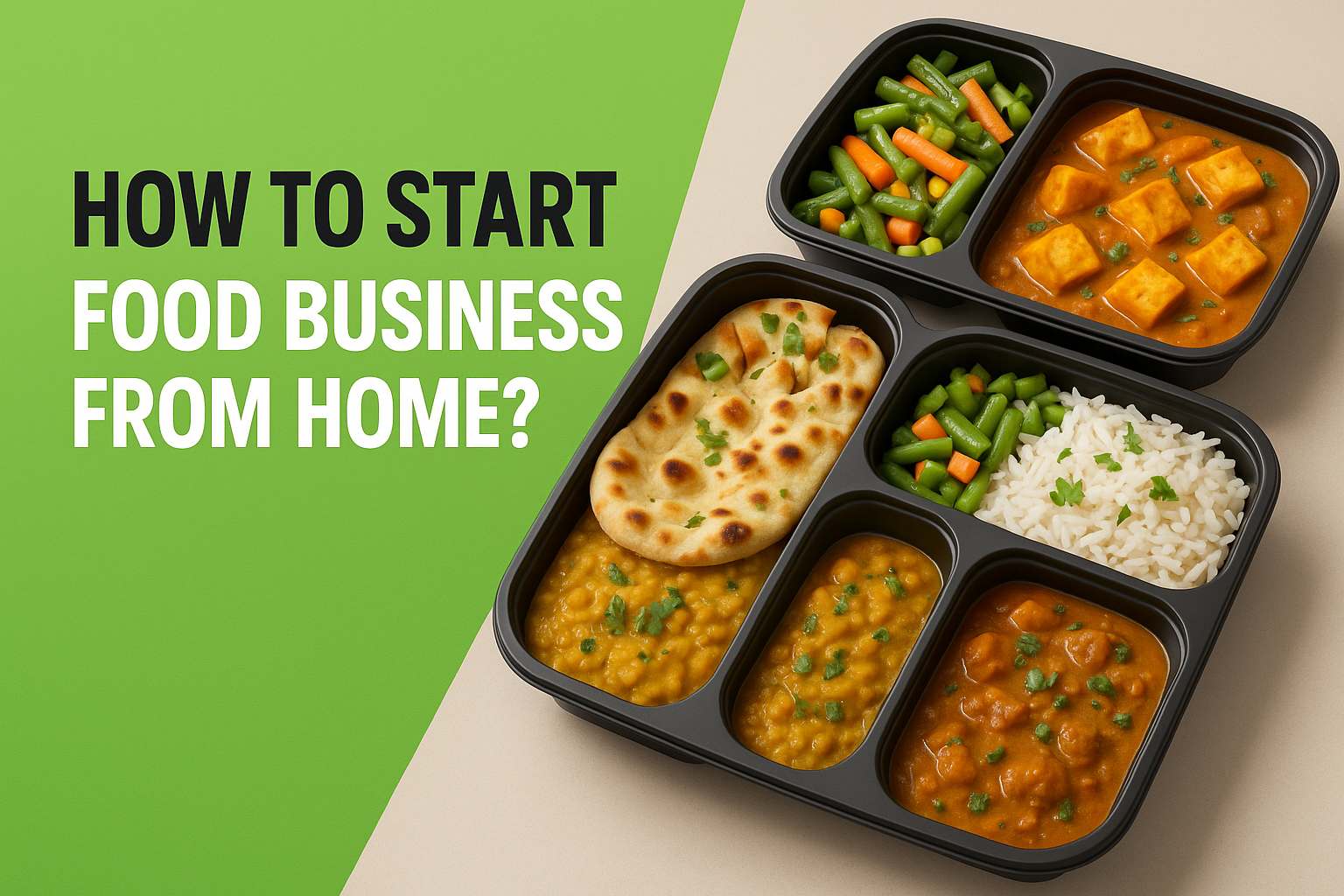Quick Links
ToggleThe culinary landscape in India has undergone an extraordinary revolution. With rising disposable incomes and a growing appetite for convenience, food businesses from home have become increasingly attractive.
A food home delivery business is still one of the most profitable businesses in India. Here’s why:
- A 2024 report valued the Indian food delivery market at about $45.15 billion, with projections soaring to $320 billion by 2033. [Source: IMARC]
- In parallel, India’s quick commerce market is slated to hit $9.95 billion by 2029 with a CAGR of 16.6%. [Source: Business Standard]
- Delivery giants like Swiggy and Zomato boast millions of users, with Zomato taking the lead with 1.84 crore users, illustrating the scale of opportunity. [Source: NDTV Profit]
- Additionally, the Indian cloud kitchen industry was valued at $1,097.5 million in 2024 and is estimated to reach $3,211.7 million by 2033. [Source: IMARC ]
- The Indian Food & Beverages Market was valued at $332 billion in 2023 and is projected to grow at a CAGR of 11.05% from 2024 to 2030, reaching $691.47 billion by 2030. [Source: Maximize Market Research]
So, if you ever dreamt of starting a home-made food business, the timing couldn’t be better.
How to Start a Food Business From Home? Step-by-Step Guide
Embarking on the journey to start a home-based food business requires a clear roadmap. Below, we will walk you through each essential stage to turn your culinary passion into profit:
Step 1: Research
-
Identify Your Audience
Before you even begin thinking about starting a home-based food business, it’s essential to identify for whom you want to cook.
- Are your potential customers young professionals rushing between meetings?
- Is your food business catering to busy families who seek healthy weeknight meals?
- Are they college students craving inexpensive tiffins?
- Or perhaps are they fitness enthusiasts searching for balanced, nutritious options?
This identification is necessary to correctly tailor your offerings to your audience’s preferences. For instance, if there’s a wide student population living in your locality, offering budget-friendly meal plans could be a winning proposition.
-
Choose a Cuisine Niche
If you want to become a successful foodpreneur, it’s important to acknowledge the competition. Hence, to stand out, becoming a go-to specialist works best.
For instance, you might want to focus exclusively on South-Indian tiffins, position yourself as a purveyor of Hyderabadi biryani only, or cater to vegan and gluten-free communities. Carving out a niche can spell the difference between blending in and becoming a local sensation.
-
Analyse Competitors
No matter how inspired your recipes are, you must understand the existing business landscape. Browse through local home kitchens on food delivery platforms, visit neighbourhood tiffin services, and assess what nearby restaurants offer.
Here’s how you can get better at competitor analysis:
- Spot Menu Gaps: See what gaps are prevalent. Maybe there’s no authentic regional dessert or limited veg options.
- Check Pricing: If a thali sells for ₹200 next door, check whether you can offer yours at ₹180 and make a profit. The low price factor can create a unique selling proposition.
- Scan Reviews: Check your competitor’s reviews and see what people are complaining about. Then work on how you can provide better.
These insights will help you analyse pain points and offer better solutions, ensuring that your venture into the home-made food business delivers something fresh and in demand.
Step 2: Create a Business Plan
-
Define Your Company Strategy
Will you operate as a traditional dhaba-style home kitchen, or are you more inclined to launch a cloud kitchen that relies entirely on delivery apps? Each approach comes with its nuances.
A small dhaba may involve minimal space requirements but depends heavily on footfall, whereas a cloud kitchen focuses solely on online orders, minimising walk-in traffic. If you opt for a cloud kitchen model, bear in mind that it typically demands higher marketing outlay on platforms such as Swiggy, Zomato, or even Google Ads to drive discovery.
-
Plan Your Menu
An appealing and well-structured menu helps customers know exactly what to expect. So, print the best dishes you can make. For example, if you specialise in North-Indian home-style meals, list signature dishes like rajma-chawal and paneer-tikka.
-
Look for a Reliable Supplier Network
In a small home-based food business, the quality of ingredients directly influences your reputation.
- Establish relationships with trusted vendors.
- Ask for sample deliveries to test freshness and consistency.
- Always keep a shortlist of backup suppliers to avoid shortages during peak demand.
-
Budget Wisely
Starting a home-based food delivery business in India calls for an initial outlay ranging from roughly ₹50,000 to ₹3 lakh. These funds cover kitchen setup, essential appliances, packaging materials, and the first batch of inventory. [Source: Restaurant India]
It’s also wise to allocate a buffer, perhaps an extra 10–15% of your estimated costs, to accommodate unexpected expenses like kitchen repairs or sudden price hikes in raw materials.
-
Work on a Pricing Strategy
Calculate comprehensive costs by adding up raw materials, packaging, delivery, and any platform commissions. Factor in labour costs, even if it’s just paying yourself a modest monthly stipend, and utilities like gas and electricity. Once you know your total cost per meal, add a reasonable profit margin, say around 20% to 25%.
Build a cloud kitchen or manage a multi-restaurant platform with Zopping!
Zopping’s no-code platform supports multi-store management—perfect for scaling operations without writing a single line of code. Launch your first virtual kitchen with Zopping’s hyperlocal commerce tools.
Contact us today!Step 3: Legal Formalities and Registrations
-
Register Your Business Entity
Based on your long-term goal, choosing the appropriate business structure is important. There are 3 options to choose from: sole proprietorship, partnership, or private limited company.
- Sole Proprietorship: Involves minimal paperwork, making it ideal for home-made food business starters.
- Partnership: If you envision collaborating with family or friends, registering as a partnership firm might be preferable.
- Private Limited: If you plan on raising external investment in the future, a private limited company could be beneficial.
-
Get an FSSAI License
All food businesses in India must register with the Food Safety and Standards Authority of India (FSSAI). Depending on your annual turnover, you will require one of three license categories:
- Basic FSSAI Registration (turnover less than ₹12 lakh)
- State FSSAI License (turnover ₹12 lakh to ₹20 crore)
- Central FSSAI License (turnover more than ₹20 crore)
To apply online, visit the FSSAI portal and be prepared to submit accurate kitchen layout drawings, a list of equipment, and other required documents.
-
Register for GST
If your annual turnover exceeds ₹40 lakh (₹20 lakh in some states), GST registration is mandatory. Even if you fall below this threshold, registering voluntarily can allow you to claim tax credit on purchases, reducing overall costs.
To obtain a GSTIN, submit your PAN, Aadhaar, proof of address, and bank account details.
-
Obtain a Trade/Health License
Visit your local municipal corporation to secure a trade or health license. This license confirms that your home-based food business ideas comply with hygiene and safety regulations. Authorities may inspect your kitchen to verify cleanliness and food storage practices.
-
Register for the Shops and Establishment Act
If you intend to employ more than ten people or if your state mandates employer registration under the Shops & Establishment Act, complete the necessary paperwork. This registration ensures compliance with labour laws, working hours, and employee welfare provisions.
-
Other Approvals and Documentation
You may need a No Objection Certificate (NOC) from your housing society or neighbours, especially if you operate from a residential building. For certain products, like packaged snacks or sweets, you may require a fire safety certificate or environmental clearance.
Remember to always keep essential documents, like PAN, Aadhaar, proof of address, kitchen layout drawings, and equipment lists handy.
Step 4: Setting Up Your Kitchen
-
Decide Between Home Kitchen and Cloud Kitchen
Deciding between a home kitchen and a cloud kitchen setup impacts your startup costs and operational flow.
- Home Kitchen: It is typically located within your residence, allowing you to save on rent, but may come with space constraints.
- Cloud Kitchen: A cloud kitchen, on the other hand, is often a rented commercial space, which can be more expensive but offers dedicated areas for prepping, cooking, and packing.
-
Get the Necessary Kitchen Equipment
Once you decide what you want to open, whether a cloud kitchen or a home kitchen for your food business, consider all the necessary expenses and items required for it.
Below is a list of the essential equipment:
- Refrigerator
- Gas stove or induction cooktops
- Cooking utensils
- Cutlery and tableware
- Packaging materials
-
Assess the Kitchen Layout and Hygiene
Following a proper kitchen layout impacts the hygiene levels maintained in the space. So, arrange your kitchen to have separate zones for raw ingredients, cooking, and packing, minimising the risk of cross-contamination.
- Ensure a consistent supply of clean water for washing produce and utensils.
- Proper ventilation is also essential to maintain air quality and reduce odours.
- Implement a daily cleaning routine, sanitising worktops, chopping boards, and cooking surfaces after every use.
-
Be Careful With the Temperature Control
Food is sensitive to deal with, and maintaining it at the right temperature is essential.
- Store cold foods at or below 5 °C and hot foods at or above 60 °C to avoid bacterial growth.
- When cooking, ensure internal food temperatures reach at least 75 °C (for meats) before packing.
- Use food-grade thermometers to monitor these thresholds, instilling confidence in customers that their orders are both delicious and safe.
Step 5: Packaging
-
Work on Branding
Even though you decide to run a home-based food business, working on a business name and branding is necessary. It should be easy to remember, reflect your cuisine niche, and resonate with your audience.
Once you have a name, hire a graphic designer or use an online tool to craft a simple yet eye-catching logo. A memorable logo helps build brand recall, especially when customers scroll through multiple options on delivery apps.
-
Go for Food-Grade Packaging
Sustainability matters more than ever today, and choosing eco-friendly packaging can give you a competitive edge.
- Opt for leak-proof, microwave-safe, and FSSAI-compliant containers made from biodegradable materials.
- Clearly label each package with ingredients, allergens, and expiration dates for transparency.
-
Take Proper Packaging Precautions
Before you pack, wait for cooked items to cool to safe temperatures, usually below 60 °C. This prevents condensation inside the containers and reduces bacterial growth.
Always wear clean gloves, use tamper-proof seals, and store packed meals in a dedicated, sanitised area. For extra assurance, consider including a small desiccant packet (commonly used in packaged foods) to absorb residual moisture and keep the meal fresh.
-
Follow Food Safety Practices
When running a successful food business from home, it is essential to follow proper food safety protocols to ensure your customers are provided with top-quality food. Below are some practices to keep in mind:
- To maintain a pristine supply chain, buy ingredients from trusted vendors.
- Check the packaging dates on packed items, and inspect produce for signs of spoilage, such as wilting or unpleasant odours, before purchasing.
- Employ a “first-in, first-out” inventory method: use older stock before newer stock.
- Regularly inspect your kitchen for pests, maintain a log of cleaning schedules, and replace sponges or cleaning cloths every few days.
Step 6: Technical Support
Technology is taking the steering wheel, and with its help, running a home-based food business in India is not difficult anymore. Since the competition is tough, here’s how technology can help:
-
Manage Orders
Even if you start small, like accepting orders via WhatsApp or telephone, it is essential to track every request meticulously. A simple spreadsheet can work initially to capture order details. But you will need a proper management system as you scale your food delivery business.
Make Order Management Simple With Zopping!
Centralise website, WhatsApp, and aggregator orders in one dashboard. Enjoy real-time tracking, instant kitchen tickets, and automated alerts, so you never miss a beat.
Explore Zopping’s Order Management System-
Work on Operations Management
Operations management is again a crucial part of running a home-based food delivery business. Below are some essential things to take care of:
- Inventory Tracking –To keep track of your inventory, initially, you can use a simple Google Sheet, and when your business takes off, a dedicated inventory management tool is great to record stock levels daily.
- Quality Control – Standardise your recipes by creating a recipe card for each meal. For example, if you sell “Rajma Rice,” specify the quantity. Perform taste tests before packing and use temperature probes to confirm safe holding temperatures. Keep logs for fridge and freezer temperatures, and schedule routine deep-cleaning sessions to maintain hygiene.
-
Adopt Digital Payment
To run your small food business smoothly from home, accept convenient methods like UPI and cards, but also offer a COD option to customers who still prefer to pay in cash.
Make Your Payments Effortless & Secure With Zopping!
Connect Razorpay, Stripe, and UPI, and watch transactions flow seamlessly. Auto-reconcile every payment and get real-time sales data to fuel smarter decisions.
Explore Zopping’s Payment SystemHow to Start a Home Delivery Food Business in India?
While the figures clearly show how profitable a food home delivery business is in India, let’s not forget that several factors come into play when setting up your food business.
Below are some points to consider before diving into this industry:
-
Pick Your Delivery Model
There are 2 common delivery models with their pros and cons:
- Aggregator Partners (Swiggy, Zomato, Dunzo): Great for instant exposure, but commissions can eat into profit.
- In-House Delivery: Start by delivering yourself or hiring a single rider. This builds direct customer trust and saves on fees.
-
Maintain Perfect Packaging and Temperature Control
To ensure that your food remains good till it reaches your customers, below are some points to keep in mind:
- For Hot Items: Invest in insulated bags/boxes so curries stay hot and salads stay crisp.
- For Cold Items: Using gel packs or insulated liners helps maintain the freshness of cold items.
- Proper Handler Hygiene: Train anyone handling deliveries to use gloves, masks, and sanitiser. Customers notice these small hygiene touches.
-
Define a Realistic Delivery Radius
A food delivery business in India needs to function on a realistic delivery schedule. Here are some factors to consider:
- Cover Limited Zones in Traffic: It’s a wise decision to limit your delivery zones within 3-4 kms during peak traffic hours to avoid customer dissatisfaction.
- Assign Clear Time Slots: Offer clear time slots (e.g., lunch 11 am-2 pm, dinner 6 pm-9 pm) to avoid overcommitting and ensure quality.
-
Use Technology to Stay Organised
As your business scales, you will need the assistance of technology to stay organised.
- Scale Slowly: Start with a simple spreadsheet or WhatsApp order checklist. As you grow, consider a lightweight delivery-management app.
- Smart Business Management Solution: A dedicated dashboard ensures you know which orders are pending, packing, or out for delivery.
Partner With Zopping!
Track orders, streamline packing, and cut delivery delays with Zopping’s Order Management System.
Explore Now-
Expand Smartly
It’s always recommended to start small and then grow with planned intentions. Here’s how you can do that and make your food delivery business a hit:
- Self-Delivery First:Begin by handling deliveries yourself or with one rider, as it is more efficient and cost-saving.
- List on Aggregators Later: Once you’re doing steady daily orders, expand via Swiggy or Zomato to reach new areas.
- Watch Your Margins: If platform fees make your bestseller too pricey, adjust the dish or packaging to stay profitable.
-
Define Your Delivery Zones With Precision
- Use Pincode Filters: Accept only orders you can fulfil to avoid wasted effort and cancellations.
- Target High-Density Areas: Draw custom zones around apartments, offices, or busy streets to get more orders with less effort.
Scale Your Online Home Food Business With Zopping!
Once your home-based food business is up and running, scaling operations while maintaining top-notch quality and customer satisfaction becomes the next pivotal step. Zopping is designed to support entrepreneurs at every stage with a comprehensive suite of tools that streamline complex operations and make the process simpler.
- Delivery Area Management: Define service zones by pincodes, radius, or custom maps to lessen wasted trips or failed deliveries with Zopping’s Delivery Area Management tool.
- Delivery Partner Integration: Link Swiggy, Zomato, Dunzo, and local riders directly with Zopping’s Delivery Partner Integration dashboard. No more manual coordination, just fresh food arriving on time!
- Smart Order Management: Manage everything with the Order Management System on one dashboard. Get real-time updates, instant kitchen tickets, & smart routing at one place.
- Custom Store Builder: Use Zopping’s no-code drag-and-drop Store Builder to launch a branded, mobile-friendly food store in minutes.
- Integrated Payment System: With Zopping’s secure payment gateway offering UPI, cards, wallets, and net banking, payments auto-reconcile, and you get real-time sales insights.
Starting a Food Business From Home?
Zopping helps you go from concept to a fully functional online store, complete with delivery integration, marketing, and mobile support. Book a demo and start building your food brand today.
Contact Us Today!



